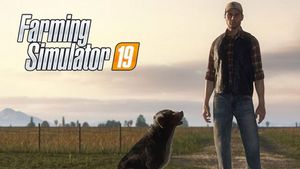Farming Simulator 19: Grains - how to grow? Guide Farming Simulator 19 Guide and Tips
Last update: 04 May 2020
In Farming Simulator 19 you can grow various types of crops. Each of them has its own characteristics and requirements, as well as machines that need to be used to harvest the crop. In this chapter you will find a step by step guide on how to grow plants, how to prepare the field for cultivation and harvest the crop. These tips apply to almost every plant, but focus mainly on grain crops.
Plowing

The first step is plowing. You can use a plow for this task. This is a very hard job and you need to do it with a powerful tractor. Luckily, Farming Simulator 19 also offers subsoilers - they are lighter, less demanding and cheaper; the only practical feature that distinguishes subsoilers from plows is that you can use the plows to create new fields or combine existing ones (on the parcels you own).

Plowing is not always required - in the case of common grains cultivation is often enough. Plowing is required when:
- You want to change the type of crop (get rid of plants growing in the field);
- Some plants require plowing before planting (e.g. potatoes, reeds and beets);
- Plowing is recommended after each crop of maize, potatoes, beet and reed: if you don't plow the field, the yield will be reduced by 15%.
- If you play at balanced difficulty, plowing is required every third crop to maintain soil fertility (when you stand in the field, in the lower right corner you will see an info box - if the soil requires plowing, you will be informed in orange text). You will also see this information on the map: a field that requires plowing will be marked in red.
- If you plow, you don't need to cultivate - sow away!
Cultivation

Cultivation can be performed instead of the arduous plowing, but only for some plants: grains and sunflower; optionally corn. As a rule, if possible, it is better to carry out cultivation INSTEAD of plowing - it is faster, less-powerful machines are required to operate the cultivators, and the machines are decently priced (and often have a built-in seeder / fertilizer spreader). Plants for which cultivation is sufficient: wheat, barley, oats, sunflower, corn (with a -15% yield loss without plowing).
- Tip: the vast majority of cultivators have an in-built seeder and/or fertilizer spreader: you can carry out two or even three actions in one go!
- Tip 2: Cultivation does not affect yields: after plowing, you do not have to cultivate the soil.
- Tip 3: You can find cultivators in the shop under the following categories: Cultivators, Power/Disc harrows, and Planters/Seeders (here you will find the machines that plant and cultivate at the same time).
- Tip 4: Farming Simulator 19 introduces a new shop category: Disc/Power harrows. They are also cultivators, but of a different design. They are characterized by: higher work speed, lower price, lower power requirement of the tractor. However, they do not combine the features of seeders/planters.
Sowing and planting
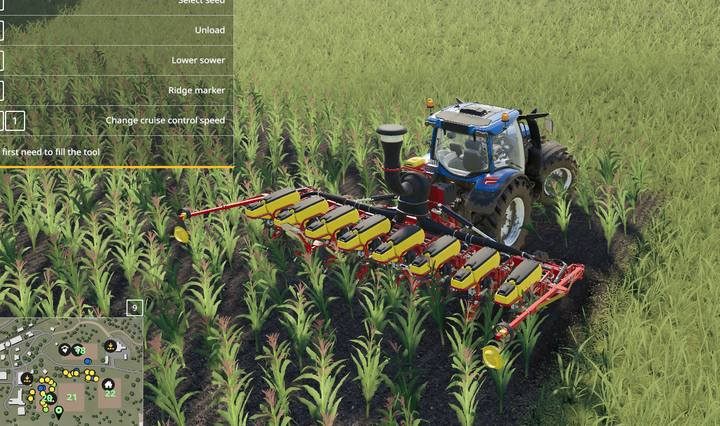
Sowing is a simple and (usually) quick action. Different types of tools are needed for different plants:
- In the Seeders category you will find tools for sowing wheat, rye, rape, oats, soybean, grass and oilseed radish (natural manure).
- In the Planters category you will find tools for planting corn, sunflower, soybean, sugar beet and cotton.
- Potatoes and sugar cane have their own categories, and you will find the planters yourself (Potato / Sugar cane / Beet technology).
- Poplars and trees are also subject to different rules. You can find a special planter in the Forestry equipment category, and detailed information about their cultivation can be found in the Woodworking industry chapter.
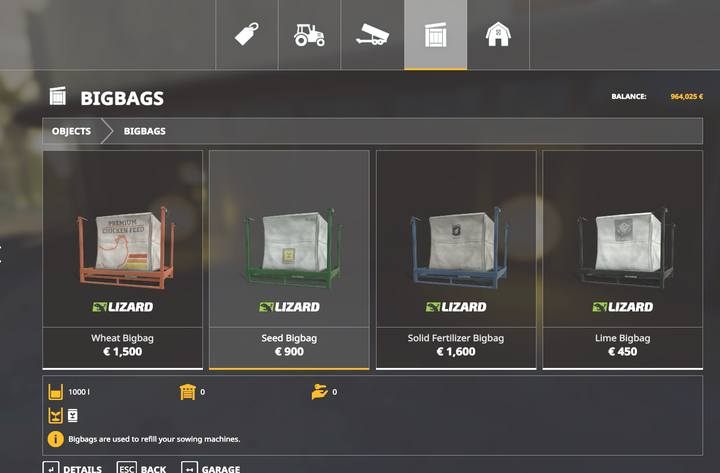
Remember that the tools have to be filled from seed pallets beforehand. It's a good idea to transport several pallets near the fields that you're cultivating in order to have easy access to seed supply.
As a rule, grains can be sewn together with cultivation, as was mentioned above in the description of cultivators. Some planters can also be connected to e.g. power harrows, which act as cultivators. Trench plants always require plowing.
Fertilizing

Fertilization is an important activity for increasing the yields from a given field. After each harvest, the fertility of soil returns to its basic level. You can fertilize the field before the sowing/planting stage. You can only fertilize again at each subsequent plant growth stage. For maximum efficiency, fertilize the field twice: preferably during sowing/planting and at any stage of plant growth - but before they are ready for harvest. Farming Simulator 19 offers many possibilities to improve the condition of your fields:
- Liquid fertilizers - you can buy them in the shop on large pallets. This type of fertilizer systems are often quite expensive, but they offer the greatest area of effect and speed of action.
- Artificial fertilizers, loose fertilizers - this technology is used by many seeders and planters, which can fertilize fields at the same time. These machines also need to be refilled in advance from pallets purchased in the shop. This is the best method early in the game: simple, common and relatively cheap.
- Slurry and manure - produced by cows and pigs as a by-product. For their distribution you need special machines, which you will find in the shop.
- Digestate - if you acquire silage (place the collected grass in a pile, whisk and wait for it to ferment; wrap bales of grass or hay and wait for the silage), you can deliver it to the Biomass plant. It will earn you money and you will be able to acquire digestate to fill the slurry tanks.
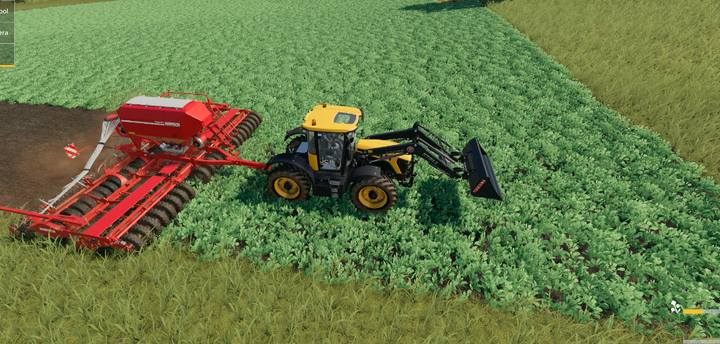
- Oilseed radish is the cheapest and simplest method of fertilization. Use a seeder to plant the radish. When it grows, use a cultivator (preferably with a seeded) to destroy the radish that will enrich the soil. This method is the cheapest because it only costs you seeds. Additionally, you can "destroy" the radish already in the first stage of its growth - when the first leaves appear.
Weeding

Farming Simulator 19 introduces a small handicap: weeds appear on your fields over time. Use a weeder to dispose of them. Another option is chemical spraying: most spraying machines can be loaded with artificial fertilizer or herbicide (both available on pallets in the shop).
- If you allow the weeds to grow in your field until harvest, the yield will be reduced by 20%.
- Important: Weeds can only be removed during the first stages of plant growth - once the crops are ready for harvest, none of the methods yield results.
- Remember that if you drive across a field where the plants have reached at least the second growth phase, you are destroying the plants. You can disable this parameter in the game options or use vehicles with narrow tires; you can equip most tractors with them.
- Tip 1: If weeds appear on a field you have not yet sown, both cultivation and ploughing will destroy the weeds. In an empty field, you don't have to use either spraying or weeder.
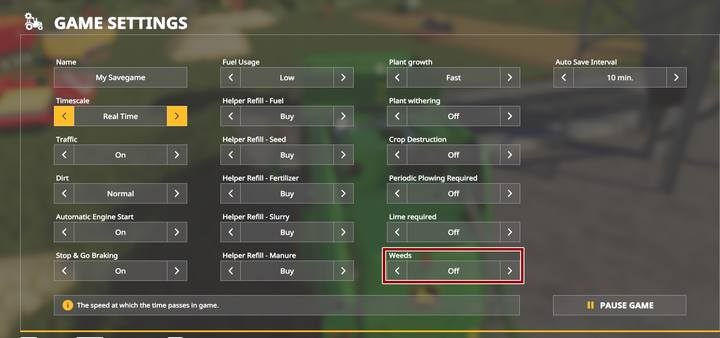
- Tip 2: if weeds are too much for you, you can also disable them in the game options.
Lime

By default (this option can be turned off in the game settings) Farming Simulator 19 requires you to periodically (every third crop) enrich the soil with lime. There are only two machines that can do it: Bredal K105 and its high-capacity model: K165. This is similar to standard soil fertilization; on the map the field requiring lime will be marked in blue. You must also use lime if you are creating new fields, expanding existing fields or combining two fields.
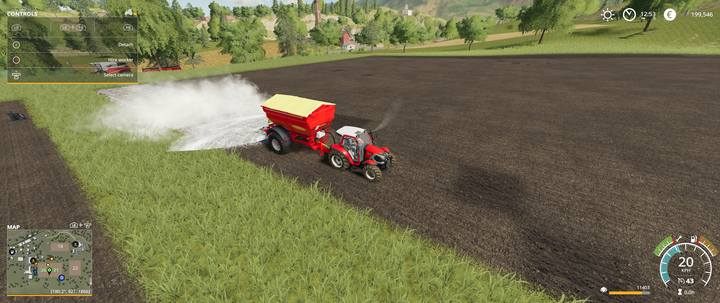
If you don't use lime on a field that requires it, your harvest will be 15% lower. This stage does not fertilize the soil like fertilizer - it is an independent factor influencing the yield of the field.

You can fill the lime spreaders at the shop by purchasing pallets with lime. If you want to carry out this process faster, look for white markers on the map: arrows pointing downwards. In these places you can immediately fill the entire machine from large tanks.
Withering

If you let your plants stay in the field for too long, they will wither. You can't do anything with them: the field must be plowed or cultivated and sown. How quickly the plants wither can be seen on the map: the field in which the plants are waiting to be harvested is yellow and goes through two successive phases (up to dark orange). If need to harvest crops from several fields, select those that have the darkest color on the map first. In such a situation it is also worth slowing down time in the game options. In the settings you have the option to turn off plant withering. Sugarcane does not wither.
Harvest


Harvesters are used for harvesting. All grains use the same type of harvester, with sunflower and maize requiring a suitable module. This is not the case with the rest of the plants:
- Grains: wheat, barley, oats, rapeseed, soybean - harvested using a grain module.
- Maize and sunflower - with the maize module,
- Sunflower - if you grow it in bulk, you will find a special module exclusively for harvesting sunflower; the harvester then moves 50% faster.
- Potatoes, sugar beet, cane and cotton - each of these plants requires a special harvester, available in two versions: cheaper - connected to the tractor; more expensive - self-propelled.
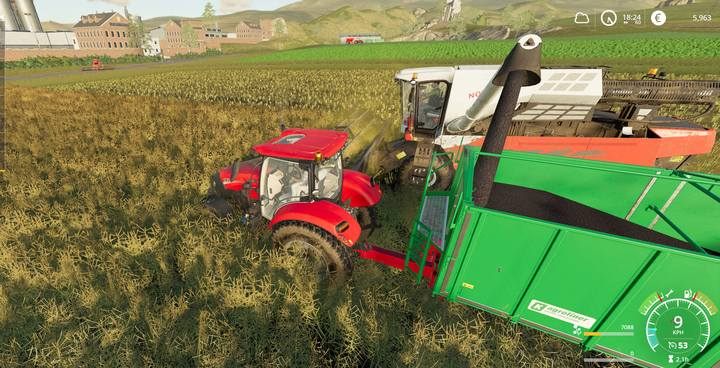
Most harvesters are don't have the capacity to hold all the yield during a harvest. Use a semi-trailer vehicle to empty the harvester and allow it to continue working. You can pour potatoes and beets straight into the field to collect them later. Cotton leaves large blocks of bales behind, to be harvested with special trailers.

